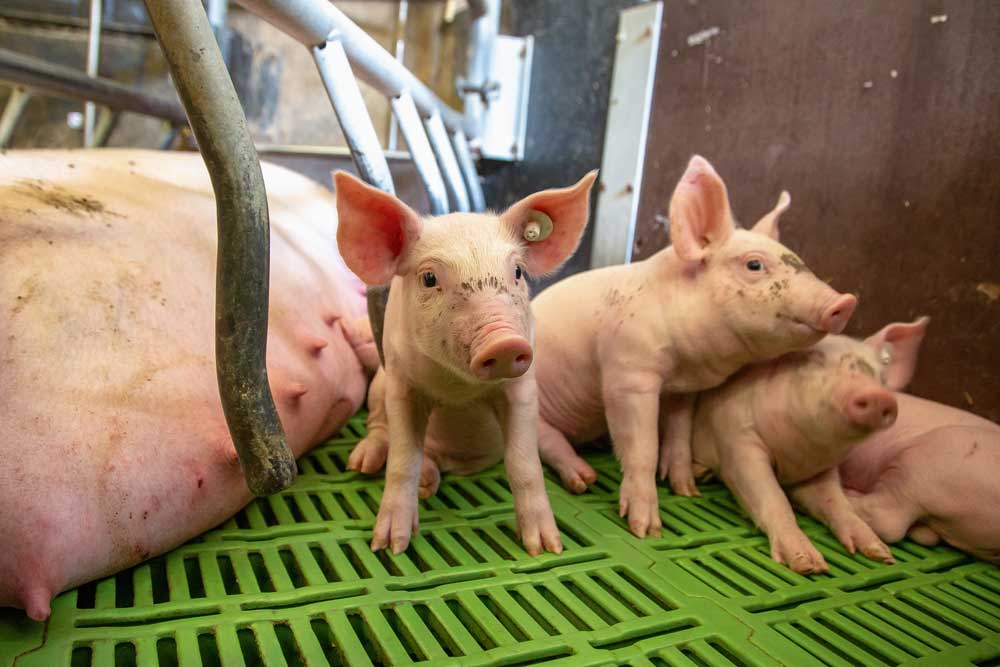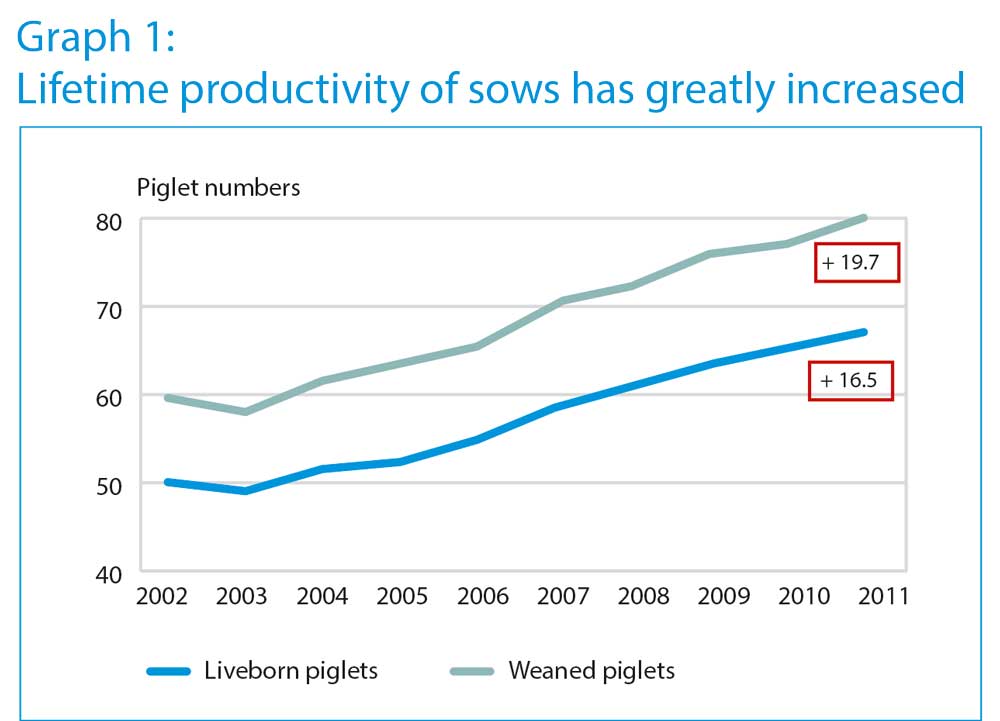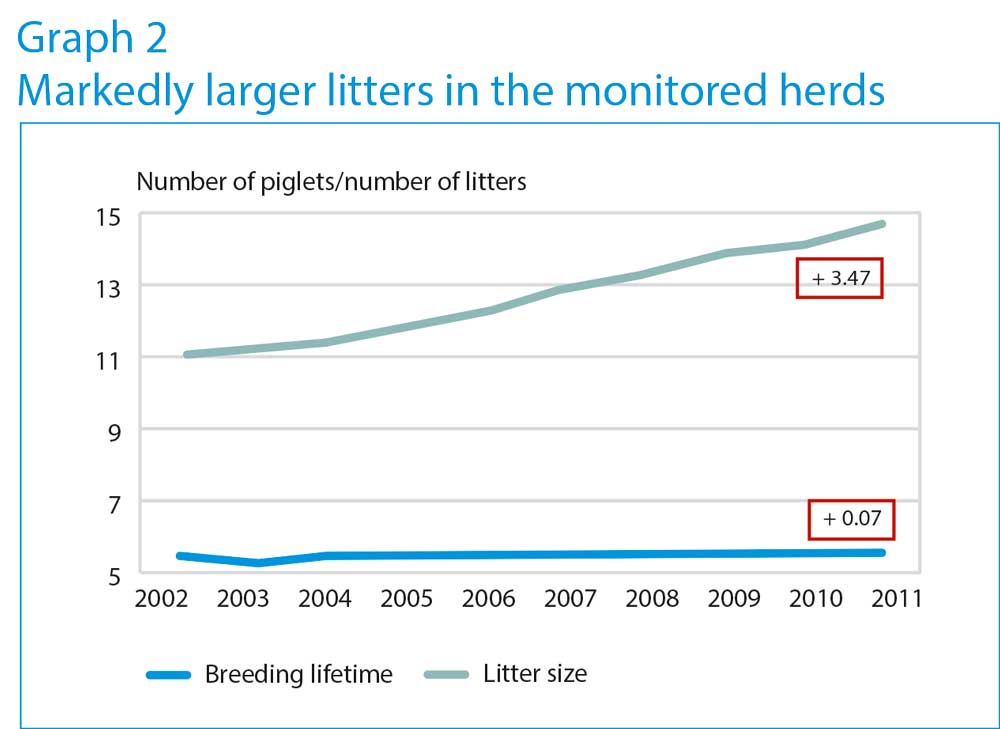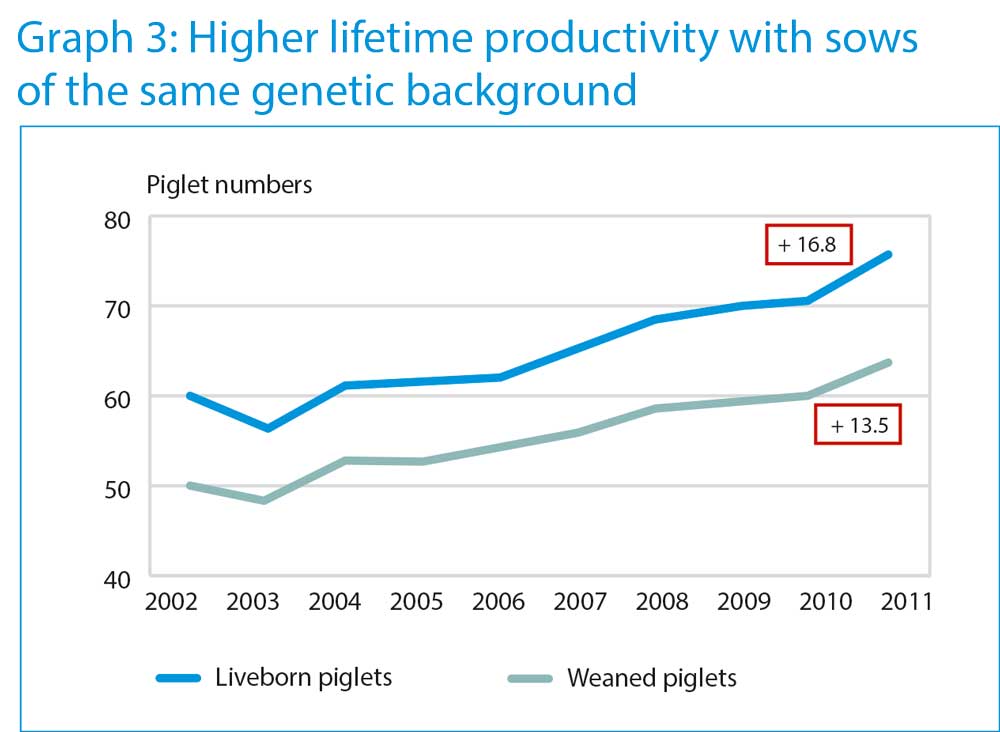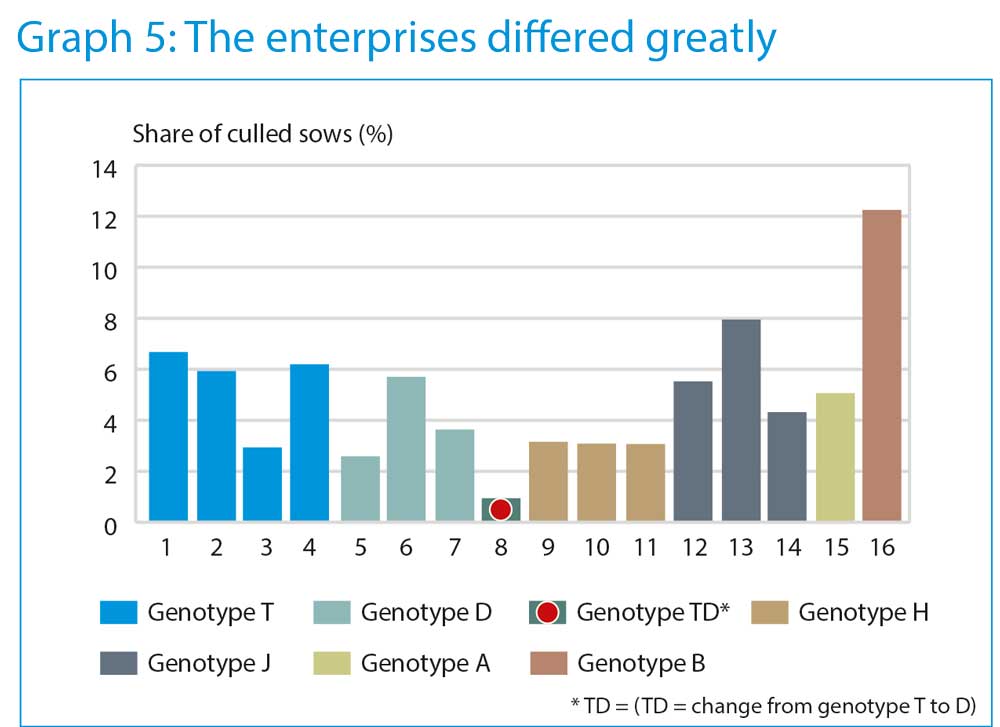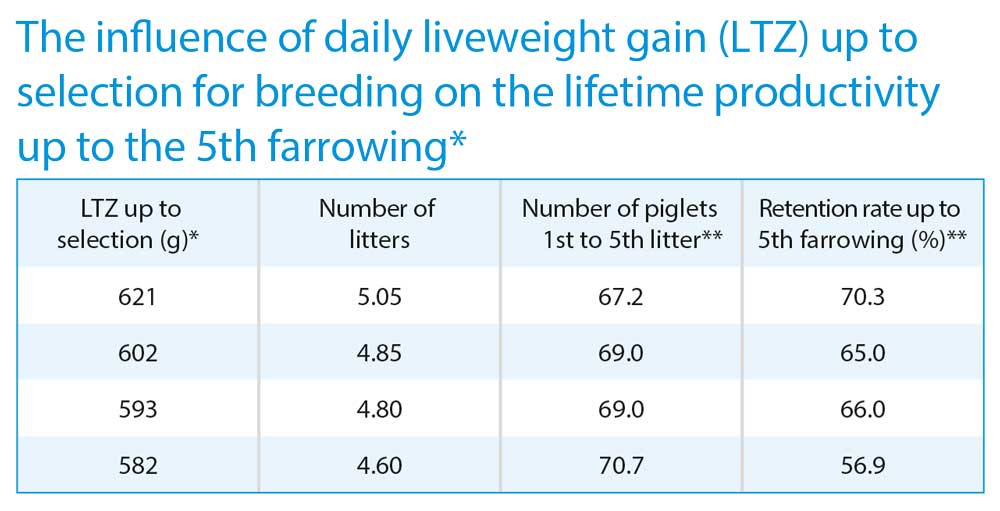More piglets - and more litters too
By Prof. Dr Steffen Hoy, Justus-Liebig-Universität Gießen, and Birgitt Hameister, VzF GmbH Uelzen
Litters in Germany, as in other countries, have become increasingly larger in the past years: by 0.2 piglets per litter and year. Up until a short time ago, average lifetime production of a sow was given as between around 41 to 64 piglets born alive. It was additionally maintained that sows producing large litters do not achieve long productive lives.
The longevity of sows described through lifetime litter production, however, substantially influences piglet production efficiency as fewer young sows are required as replacement breeding gilts. Premature departure of breeding sows from a herd can be caused by many factors. Nevertheless, this occurs too often. In some herds, in extreme cases, only 61 % of breeding females achieve a second farrowing, although there are herds where 100 % of sows are still present during second farrowing.
As lifetime productivity for a sow, or a herd average, is understood total born and liveborn piglets produced including, where applicable, own piglets that are fostered in other litters. Breeding lifetime, on the other hand, defines the number of farrowings achieved by a single sow, or the average for a herd, Has the increase in litter sizes led to a shortening of breeding lifetime? And what are the factors influencing breeding lifetime and lifetime productivity?
Development of lifetime productivity and breeding lifetime
In the ten years from 2002 to 2011 (in each case the year of first gestation), sow lifetime productivity based on liveborn piglets as well as weaned piglets in the 27 monitored VzF herds increased. With sows from first gestation year 2002, lifetime productivity based on total liveborn piglets was 60.
Up to 2011 this productivity increased by 19.7 to 79.7 liveborn piglets in herd average. An almost parallel development was recorded for piglet numbers at weaning. This figure rose from 51.7 for sows with FI in 2002 by an average 16.5 for all piglet production herds to 68.2 for the 2011 first gestation sows (graph 1).
Number of liveborn piglets increased
In the period 2002 to 2011 the herd average litter size in terms of liveborn piglets increased from 10.92 to 14.39 (graph 2). Over ten years, litter size thus increased by 3.47 liveborn piglets per farrowing – a plus per annum of 0.35 liveborn piglets per litter. With this, the high-performance VzF herds achieved an above-average performance increase: in many other herds the rise in litter size over the same period being around 0.2 liveborn piglets per litter and year.
Despite this considerable increase in piglets produced, the breeding lifetime of the sows had not decreased but instead had slightly risen by 0.07 litters/sow to an average of 5.5. With that, it lay markedly higher than assumed before. There emerged, in fact, a highly significant positive relationship between litter size and breeding lifetime, i. e. with increasing size of litters, sow breeding lifetime also increased slightly.
Analysing according to genetic origin
Sow genotypes differed between the selected herds. Because it is recognised that there are marked differences in litter sizes produced by different genotypes and that this effect could influence the breeding lifetime figures, in a second step the analyses were carried out on sows from one genetic origin. Hereby it was possible to confirm a substantial rise in lifetime production with liveborn piglets and at weaning over the ten years in the 13 selected herds where sows had the same genetic background. The lifetime productivity in terms of liveborn piglets increased by 16.8 and with weaned piglets by 13.5 (graph 3).
Hereby the increase was slightly more moderate compared with the average of all herds.
During the evaluation period, the number of liveborn piglets per litter from sows with uniform genetic background increased by 3.08 – from 10.90 to 13.98. As in the total recorded data, the rise in litter size accompanied a slight increase in breeding lifetime which here increased from 5.30 to 5.37 litters on average over the sow lifetime (graph 4).
Large difference between herds
The evaluation in the 16 herds with six different genotypes showed the differences in breeding lifetime and in the lifetime productivity between the herds were greater (in the extreme 4.58 to 7.11 litters/sow) than between different genotypes.
With genotype T, breeding lifetime fluctuated between the four herds with this genetic background from 5.22 to 6.23 farrowings per sow – a very large difference. With genotype J, the difference between the herds with the highest breeding lifetime and those with the lowest was 0.53 farrowings per sow based on the averages of the respective herds.
There were also very great differences in lifetime productivity between the piglet production herds. Between the worst performing herd with 58.8 liveborn piglets per sow and the best with 95.2 liveborn piglets per sow lay a difference of 36.4 liveborn piglets per sow with every sow in herd 8 producing more piglets than the average sow performance in herd 4. At the same time, it should be recognised that there were definitely differences on average between the genotypes. The highest lifetime productivity was achieved by genotype D sows, the lowest those from genotypes J and T. The genotypes A and B are regarded as not representative in this respect as only one herd for each genotype was available.
Influences on lifetime productivity and breeding lifetime
Heritability of breeding lifetime is low, thus health status and herd management are the decisive objective or subjective factors influencing a long useful life. This is explainable when (16 herds evaluated) between 0.8 and 12.3 % of gilts in the herds are culled even before first farrowing (graph 5). Here too, the differences between the herds are markedly greater than between the genotypes. Without knowing precisely the conditions in the respective enterprises, it must be assumed that, above all, animal health problems (possibly unprofessional integration of gilts after selection), and in management, are reasons for extremely high losses amongst gilts before first farrowing. Also to be added is the possibility of an unknown number of gilts not even inseminated and so not registered in the respective sow planners.
A further factor is the age or sexual maturity at first insemination. For this, gilts should be in their second, preferably third, cycle with about 240 to 250 days of age. However, there arises the question of what herds have information available on start of puberty of the gilts. A first insemination at the age mentioned is based on a puberty age of some 200 days. Research on automatic heat control aided by a heat detector with 311 gilts in a herd did, in fact, identify an average age at heat detection between 201 and 207 days. Other research found, when applying progesterone concentrate, first insemination age and return to service figures, that possibly only 27 % of gilts in four herds were already sexually mature between 160 and 200 days, whereby in some herds the proportion of animals not sexually mature was up to 80%.
Early maturity of advantage
The early onset of puberty in association with above-average physical development has a positive effect on breeding lifetime and lifetime productivity. This is the result of our analyses involving 760 gilts that showed that animals with above-average daily liveweight gain (over 600 g) up to selection for breeding achieve a significantly higher retention rate up until the fifth farrowing (70 or 65 %) than pighouse neighbours with under-average daily liveweight gain up to selection (66 or 57%, see table).
Finally, a total of 1,406 gilts in three herds were analysed to investigate the relationship between the sum of total born piglets in the first two farrowings and the lifetime productivity. Thereby in all three herds a similar positive high correlation coefficient existed. The more piglets the sows produced in the first two farrowings, the higher was the lifetime productivity.
Conclusion
- The size of litters has increased in the last ten years by around 3.5 piglets and lifetime productivity by almost 20 liveborn piglets. Despite this substantial increase, the breeding lifetime has not reduced, but instead even increased slightly. In 27 herds the average lay by approx. 5.5 farrowings and so markedly higher than assumed beforehand. The genotype had no influence on the breeding lifetime results but probably had some influence on the lifetime productivity.
- The heritability for breeding lifetime is low, so that health status and herd management have more influence.
- The frequency of gilts culled without farrowing at all is (in own herds) much too high, at up to 12.3%.
- An early start to puberty in association with an above-average physical development positively influences breeding lifetime and lifetime productivity.
- The cumulative piglet number from the first and second farrowing permits prognosis on lifetime productivity.



